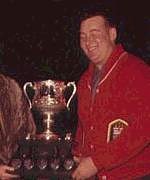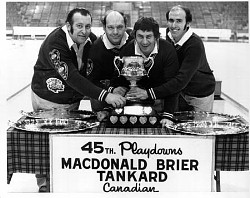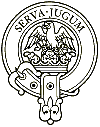| The following
is an excerpt of an article penned by Warren Hanson for the 1999 Brier
in Edmonton, on the life of the late Hec Gervais. He has kindly consented
to allow me to reproduce this article here. |
|
|
CURLING LEGEND: HECTOR
GERVAIS
By Warren
Hansen |
| Most kids
idolize sports figures, people they dream of emulating as they grow toward
adulthood. |
 |
| When I was
a child in my native Edmonton, my heroes were curlers and football players.
My goals were to play football for the Edmonton Eskimos and develop into
a championship curler like Matt Baldwin and Hector Gervais. |
| In 1958, Baldwin
was in the process of winning his third Brier and Gervais was the new kid
on the block, and the one most likely to challenge the king. |
|
|
| While Gervais
hadn't yet made an appearance at the provincial level, he had been gaining
a good deal of attention with repeated first-event and aggregate wins in
the annual Edmonton bonspiel. I remember the radio broadcasts of
those final Saturday finishes when Gervais - always referred to as the
large potato farmer from St. Albert - would generate some magic to win
another bonspiel title. |
| In 1960, Gervais
teamed up with Baldwin to form what most felt would be the 1960 Alberta
championship team. I was just 16 and had just acquired my drivers'
license, which allowed me to drive from my home north of Edmonton to watch
Baldwin and Gervais humble their opponents in the finals of the Northern
Alberta playdowns. |
| But they went
down to defeat a week later in the Alberta final and that was the end of
the Super Squad. |
| Gervais was
back on the teehead the following year with two relative unknowns -- Ray
Werner at the second and Ron Anton at third. Wally Ursuliak, no stranger
to the Edmonton curling scene, rounded out the team at lead. |
| Anton was
the real surprise. Only 19 years old, he threw the stone with a balance
and accuracy seldom seen. Gervais had apparently scouted the Medicine
Hat native for a few years before Anton entered a Catholic seminary to
become a priest. He had left the seminary to become Gervais' third. |
 |
| The new team
was a solid unit and swept the Alberta playdowns to enter its first Brier
at the Calgary Corral in 1961. Saskatchewan's Jack Keys proved to
be a formidable foe, but in the end Gervais prevailed and managed his Brier
win. |
| The Alberta
foursome appeared again at the 1962 Brier in Kitchener, Ontario, only to
be defeated in a playoff by Saskatchewan legend Ernie Richardson.
By the end of that curling season, all of Gervais' team members were household
names in Edmonton curling circles, the curlers kids most wanted to emulate. |
|
|
|
| Through the
mid-1960s I struggled up the difficult competitive ladder in Edmonton.
During that same period, the Gervais team experienced its own struggles
and, while its success on the money trail was second to none, a third appearance
at the Brier evaded it. |
| In 1968, I
was playing third for Wayne McElroy; we thought our team was solid and
that we had finally arrived. We breezed through the A side of the
city playdowns, only to find Hector Gervais standing between us and a berth
in the Northern Alberta playdowns. It was a game to remember.
It went right to the wire, and our young team squeezed out a last-rock
victory. |
| Gervais dropped
to the B side but lost another qualifying game and didn't make the Northern
final for the first time in years. Although we lost that Northern
final, one of our greatest accomplishments had been winning the A section
final against the two players who had been the idols of my youth. |
| Many changes
took place in the Edmonton curling scene during the next two years and,
in 1970, I made a fresh start with Ron Anton as my skip. For the
next three years we head great success on the cashspiel circuit but were
unable to win a zone in the city playdowns. One of our greatest obstacles
in achieving that goal was Anton's former skip, Hector Gervais. |
| During those
years Gervais was struggling, but whenever he played us he was at his best.
During those three years we never beat him. It was one of the interesting
traits of this amazing man: he was repeatedly able to rise to the occasion
against former teammates. |
| Anton and
I met after the 1972 season to discuss our future. Anton said he
didn't feel comfortable on the teehead and suggested he would prefer playing
third, where he was one of the best in the game. We had two choices:
if we were to continue to curl together, either I had to skip or we had
to find a new skip and I would play second. After considerable deliberation,
we decided our best move would be to find a new skip. |
| We tossed
a couple of names around and at some point Anton suggested Gervais.
We thought about it for a couple of days and finally decided to give him
a call. A short time later we met and the deal was sealed.
Darrel Sutton, who had played lead for a year with me and Anton, rounded
out the team and away we went into the 1973 season. |
| We did well
on the cash circuit but the Edmonton playdowns were a disaster. Memory
tells me that it was all over for us in about four games. |
| The failures
continued to pile up during the fall of 1973. Although we had been
quite successful a year earlier on the bonspiel circuit, we couldn't repeat.
Gervais was now 41 years old and it seemed that time had taken its toll.
He still had an occasional burst of brilliance, but he was inconsistent
and his interest seemed to be waning. Shortly after Christmas, Anton
and I met to discuss the upcoming playdowns. It seemed our season
would be short-lived, but we decided to give it our best shot and finish
out the year. |
| I
will always remember the first day of the 1974 city playdowns. We
were playing on an outside sheet of ice at the Shamrock Curling Club against
a worthy opponent by the name of Ken Watson (no relation to the former
Manitoba great). We were in the second end and Darrel Sutton and
I were standing at the hogline watching play on an adjacent sheet.
All of a sudden I heard a yell from behind our sheet: "Hey, you guys, we're
playing on this sheet of ice." I snapped my neck around so quickly
I nearly got whiplash. The voice was Gervais' and, while he had been
pretty passive for several weeks, it seemed he was back in the game.
For the next month the man was brilliant, making shot after shot, many
of which seemed impossible. We won the city zone, the Northern Alberta
berth, the province and, finally, the Brier in London, Ontario. |
|
|
 |
| Although we
lost a last-rock semi-final in the world championship in Berne, Switzerland,
our season ended as a dream come true. A team that had struggled
throughout almost the entire season had, under the guiding hand of a once-great
champion, gone from oblivion to the world curling championship. |
| During those
few short weeks I was fortunate to witness the magic of one of the greatest
curlers of all time. In many ways, Gervais' performance defied all
logic. A huge man - about 270 pounds - he delivered the stone in
a totally unorthodox manner and very often called shots that seemed impossible.
Yet he came through time and time again. His key demand of his players
was to have faith and never question what he was doing or calling, regardless
of how wrong you felt it was. |
|
|
|
| Some felt
Gervais was difficult to play for - and for some he could be. Although
he was known as the Friendly Giant, he certainly wasn't friendly on the
ice. No one was more competitive and demanding of his team.
He was a man of good humor and quick wit and always liked to make jokes
about his teammates. One of Gervais' tongue-in-cheek philosophies
was that it would be great if you could create a team that would have a
skip and three robots. He also suggested to his front end on more
than one occasion that all they had to do was sweep and throw the rock;
he would do the thinking. |
|
|
| I could go
on with Gervais stories for pages. He provided the greatest curling
season of my life and I will never forget the thrill of winning and playing
in a Brier with the big guy and Ron Anton. |
| On July 19,
1997, Hec Gervais succumbed to a massive heart attack at the age of 63.
He had been plagued by heart problems for almost 20 years and had undergone
heart surgery in 1987, but it was still too early for him to die. |
| His passing
was a great loss to curling - he was a legend around the world - particularly
in his native Edmonton, where he was an institution. |
|
| Copyright
© 1998 Labatt 1999 Brier. All Rights Reserved. |
|
| Warren
Hansen is the CCA's Manager of Event Operations & Media, as well as
Managing Editor of Extra End magazine. |
|
 -BACK
TO MAIN PAGE -BACK
TO MAIN PAGE |



